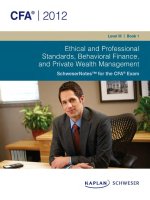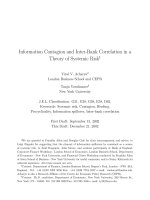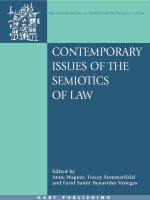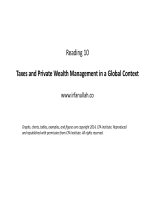R10 taxes and private wealth management in a global context
Bạn đang xem bản rút gọn của tài liệu. Xem và tải ngay bản đầy đủ của tài liệu tại đây (91.87 KB, 29 trang )
Reading 10
Taxes and Private Wealth Management in a Global Context
www.irfanullah.co
Graphs, charts, tables, examples, and figures are copyright 2014, CFA Institute. Reproduced
and republished with permission from CFA Institute. All rights reserved.
Contents
1.
2.
3.
4.
5.
6.
Introduction
Overview of Global Income Tax Structures
After-Tax Accumulations and Returns For Taxable Accounts
Types of Investment Accounts
Taxes and Investment Risk
Implications for Wealth Management
www.irfanullah.co
2
1. Introduction
• Learn basic concepts which serve as foundation for building
tax-aware investment models
• Develop framework with which advisers can communicate
impact of taxes on portfolio returns
www.irfanullah.co
3
2. Overview of Global Income Tax Structure
Taxes on Income
Wealth-Based Taxes
Taxes on Consumption
2.1 International Comparisons of Income Taxation
2.2 Common Elements
2.3 General Income Tax Regimes
2.4 Other Considerations
www.irfanullah.co
4
Example 1. Progressive Tax Rate Structure
Ordinary income
Investment income often taxed differently based on the nature of the income:
Interest, dividends, capital gains
1. Common Progressive Regime
2. Heavy Dividend Tax Regime
3. Heavy Capital Gain Tax Regime
4. Heavy Interest Tax Regime
5. Light Capital Gain Tax Regime
6. Flat and Light Regime
7. Flat and Heavy Regime
www.irfanullah.co
5
3. After-Tax Accumulations and Returns for Taxable Accounts
Returns-Based Taxes: Accrual Taxes on Interest and Dividends
www.irfanullah.co
6
Example 2. Flat Tax Rate = 20% 7% return over 20 years Initial portfolio 100,000
1. Expected wealth after 20 years?
2. What portion of investment gains consumed by taxes?
www.irfanullah.co
7
Returns-Based Taxes: Deferred Capital Gains
www.irfanullah.co
8
Example 3. Invest 100,000 at 7% for 20 years. Pay tax on capital gain at end of 20 years.
1. What is the expected wealth at the end of 20 years?
2. What portion of investment gain consumed by taxes?
www.irfanullah.co
9
Cost Basis
www.irfanullah.co
10
Example 4. Current market value = 100,000. Cost basis = 80,000. 7% and 20 years.
www.irfanullah.co
11
Wealth-Based Taxes
Example 5. Wealth tax of 1.0% on final assets each year. Portfolio of 400,000 is expected to return 6%
for the next 10 years.
1. Expected wealth at end of 10 years?
2. Proportion of investment gains consumed by taxes?
www.irfanullah.co
12
3.2 Blended Taxing Environments
Different taxing schemes can be integrated into a single framework
Consider portion of investment return from interest, dividend and capital gain
Example 6. Portfolio = 100,000. Grows to 108,000 by year end. Interest = 400, Dividend = 2,000 CG = 3,600
www.irfanullah.co
13
Annual return after realized taxes
Example 7. Portfolio = 100,000. Grows to 108,000 by year end. Interest = 400, Dividend = 2,000 CG = 3,600
Dividend and realized capital gains taxed at 15%. Interest taxed at 35%.
1. What is the annual return after realized taxes?
2. What is the balance at the end of the year after taxes are paid?
www.irfanullah.co
14
Future Long Term Accumulation
In the previous example we did not consider of deferred capital gains taxes
If we do, the effective capital gains tax rate is:
Future after-tax accumulation:
www.irfanullah.co
15
Example 8: Future Long Term Accumulation
Portfolio = 100,000. 8% gain. 5-year horizon. Interest = 400, Dividend = 2,000 CG = 3,600
Dividend and realized capital gains taxed at 15%. Interest taxed at 35%.
Look at Exhibit 5.
www.irfanullah.co
16
3.3 Accrual Equivalent Returns and Tax Rates
Accrual equivalent after-tax return is the tax-free return that if accrued annually produces the same
after-tax accumulation as the taxable portfolio
Say 100 121 in 2 years after taxes
Accrual equivalent return is 10%
Embedded example: 100 138.66 in 5 years after taxes. What is accrual equivalent return?
Accrual Equivalent Tax Rates
www.irfanullah.co
17
Example 9. Invest 100,000 at 7% for 20 years. Pay tax on capital gain at end of 20 years.
1. What is the accrual equivalent return?
2. What is the accrual equivalent tax rate?
www.irfanullah.co
18
4. Types of Investment Accounts
Taxable Accounts
Invest after-tax money
Profits/returns are taxed (as discussed in section 3)
Tax Deferred Accounts (TDA)
IRA
Tax Exempt Accounts
Roth IRA
www.irfanullah.co
19
Example 10. 100,000 for 20 years. 7% return. Tax = 20%. Compute after-tax wealth after 20 years:
1. Taxable account, taxed annually.
2. Taxable account. Deferred capital gains tax.
3. Tax deferred account
4. Tax exempt account
www.irfanullah.co
20
4.3 After-Tax Asset Allocation
Stocks worth 1.5 million in TDA
Bonds worth 0.5 million in TEA
What are weights?
Need to consider after tax weights.
www.irfanullah.co
21
4.4 Choosing Among Account Types
TDE seems better than TDA but…
1.
Contributions to TDA are tax deductible
2.
Investors tax rate might be lower upon withdrawal
Example 11
www.irfanullah.co
22
5. Taxes and Investment Risk
For assets in taxable accounts:
Taxing authority shares investment risk with investor
Hence, taxes can reduce investment risk
See Exhibit 7 if you want to be
super diligent
For assets in TDAs and TEAs:
Investor bears all risk associated with returns
www.irfanullah.co
23
6. Implications for Wealth Management
Techniques for effectively managing tax liabilities Tax Alpha
6.1 Asset Location
6.2 Trading Behavior
6.3 Tax Loss Harvesting
6.4 Holding Period Management
6.5 After-Tax Mean-Variance Optimization
www.irfanullah.co
24
6.1 Asset Location
Three types of accounts: 1) Taxable 2) TDA and 3) Tax Exempt
Choice of where to place specific assets is called the asset location decision
TDAs and Tax-Exempt
Accounts
Taxable Accounts
Securities which would
otherwise be heavily
taxed
Lightly taxed securities
www.irfanullah.co
25









